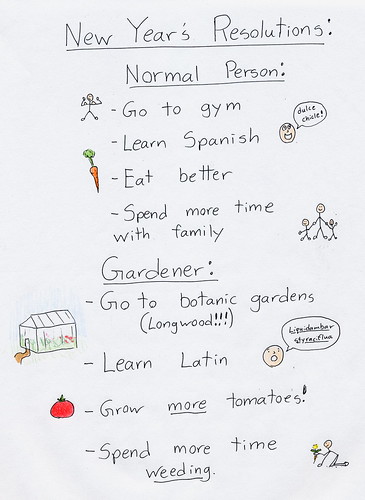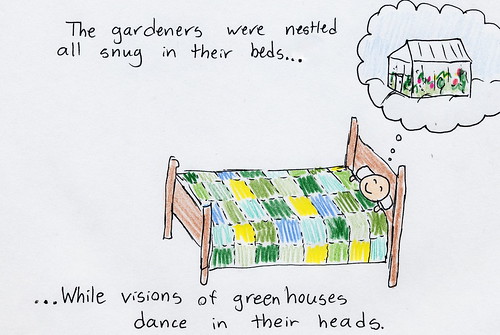Another great question from Annie of Annie's Annuals:
Is there something special about rain water ? I mean beyond "hydration"? As we are a Mediterranean climate here in the Bay Area, we have to use city water all Summer . Then, after the first rain everything goes bonkers and all my garden plants seem to grow quite a bit overnight and vibrate with inner happiness. No, I'm not currently on drugs and I swear this is true. I notice it every year. I know its not that they get watered deeply for the first time in a while- because our waterers at the nursery water everything every day whether I like it or not! Can you solve my mystery?
I think I can solve your mystery. Let me start by telling you about another mystery.
Columbus Ohio has a lovely
public conservatory which had a marvelous collection of palms. These palms had been happily, healthily growing for decades, then started mysteriously wasting away and dying. The workers at the conservatory hadn't started doing anything new, the plants weren't diseased or infested with insects. At a loss, they enlisting help from horticulture professors at Ohio State who determined the soil pH was WAY too high. Which was an answer, but lead to another question. They had been maintaining these palms the same way for decades, and everything had been fine. Why would the soil acidity suddenly get all out of wack?
Water.
The city, it turns out, gets water from three different treatment plants, and each uses water from different reservoirs and/or wells, making the water from each plant chemically different. As the city grows and changes, they sometimes switch a neighborhood from water from one plant to another, and they had changed the source for the conservatory's tap water -- but didn't mention it to them. After all, water is water, right? Nope. The new water source was radically more alkaline than the old one and suddenly all the plants that had been vibrating with inner happiness were stressed and dying. The conservatory started pH testing and treating their water with acid, and the remaining palms were saved though many beautiful trees had already died.
(a moment of silence for the palms)
The sad story of the palms goes to show that sources of water can be pretty radically different and have a big effect on plants. Truly pure water essentially doesn't exist. Water is sometimes called the universal solvent because almost anything can, and does, dissolve into it. Even ultra-super-extra-triple distilled water won't stay perfectly pure for long. As soon as it is exposed to air, carbon dioxide will dissolve into it and make it slightly acidic. So don't be fooled by "pure" bottled waters. If it was truly pure, it would cost a lot more (ultrapure, research-grade water costs about $25 a liter), and besides, extremely pure water tastes unpleasant, and isn't good for you.
City water comes from various sources like wells, lakes, rivers and treated sewage (yum...) and picks up all sorts of different minerals, salts, and gasses along the way. Water treatment plants remove some of those compounds, add others, and sterilize it to make it safe for people to drink. The emphasis here is on people, and some water treatments aren't all that good for plants. Some plants are sensitive to chlorine, and water softeners take out excess dissolved minerals in water (which are mostly fine for people or plants) and by replacing them with dissolved salts (which are very bad for plants). Rain water generally has less stuff dissolved in it than tap water, but it isn't pure either, not by a long shot. Clouds contain not just water, but also various dust, gasses, and (unfortunately) industrial air pollution, making rain water chemically different than tap water.
So how might the difference between rain water and tap water be effecting your plants? As demonstrated by the palm story I started with, pH could be a big one. Rain water is slightly acidic (or not so slightly, if you've got acid rain) whereas most tap water is alkaline due to dissolved minerals. It may be that over the summer your soil pH slowly goes up, out of the plant comfort zone, and then gets brought back down with the arrival of the fall rains. You could test this theory pretty easily be measuring your pH before and after the rains start.
Another option would be mineral and salt build up. Most tap water contains a fair amount of dissolved minerals, and fertilizers (of any sort -- organic or synthetic) are salts. As water evaporates from the soil, it leaves the minerals and salts behind, which over time can affect the health of the plants. In extreme cases, like house plant that have been around forever, you might even see a crusty white layer on the surface of the soil. Rain water is purer than most tap water, and coming in large amounts could flush out the excess minerals and salts letting plants grow more happily. You could sort of test this one by comparing your soil's salt concentration before and after the rains with an EC (electical condictivity) meter.
It could also be nitrogen. I didn't realize this until I started researching this answer, but rain water can have significant amounts of nitrogen in it (but, then again, so can tap water, especially in agricultural areas). The papers I've looked at on the subject find the amount to be pretty variable by region and season, so your local fall rains may or may not be giving your plants a fertilizer boost along with hydration.
Finally, as I mentioned above, the water treatment process adds chemicals like chlorine to tap water, which some plants are sensitive to. These may be slowly building up in the soil over the watering season gradually hurting the health of the plant.
In short, rain water is very different from most tap water, and the "inner happiness" your plant exhibit with the arrival of fall rains isn't a figment of your imagination nor a drug-addled hallucination, though it is hard to say for sure which factor or combination of factors are responsible for their joy.
Have a question? Get a sciency answer! Just e-mail me: engeizuki at gmail dot com.




